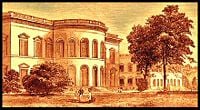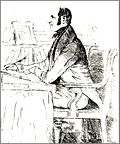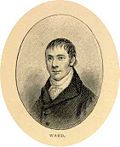Serampore College
 From Nwe
From Nwe

|
|
| Established | 1818 |
|---|---|
| Type | College |
| Staff | 79 (teaching), 30 (non-teaching) |
| Principal | Dr. Lalchungnunga |
| Students | 2,277 |
| Location | Serampore, West Bengal India |
| Campus | Rural |
| Affiliations | Senate of Serampore College (University) and University of Calcutta |
| *NAC 2004 report on the College and its degree issuing position. Retrieved June 23, 2008. | |
Serampore College, located in Serampore Town, in Hooghly District, West Bengal, India, consists of a theological college and a college of arts, science, and commerce. The Senate of Serampore College (University)[1] administers the theological college conferring theological degrees upon authority of a Danish charter.[1] The Latin name of the college motto, Gloriam Sapientes Possidebunt, derives from chapter 3, verse 35 of the Latin Vulgate - Book of Proverbs,[2] meaning, "the wise shall possess glory."[3]
King Frederick VI of Denmark originally granted a Royal Charter giving Serampore College the status of a university to confer degrees. With the later establishment of the University of Calcutta in 1857 the arts, science and commerce parts of Serampore College affiliated with the University of Calcutta. Serampore College continues to confer its own degrees in theology under the power vested by the Charter and Act of Serampore College. A private Grant-in-aid Minority College, the University Grants Commission recognized the college, under Section 2(f) and 12(b) of the UGC Act, 1956.
William Carey has been acknowledged as one of the, if not the, foremost Protestant missionaries during the Worldwide Protestant missionary movement of the nineteenth century. Protestant missionaries took Carey’s example as a model to follow. Serampore College provides a glimpse into Carey's, and the other two Serampore Trio's (Joshua Marshman and William Ward) missionary method. Carey, Marshman, and Ward founded the college as a vehicle to educate Indian students of every caste and color, and students from other countries as well in the arts and sciences. In the early 1800s, colleges in the United States, England, and Europe endeavored to provide a liberal arts education as well. In other words, the Serampore Trio aimed to provide the Indian student with the best education available anywhere. They accomplished that aim while creating a model interdenominational college.
History
Founding by English missionaries
English missionaries known as the (Serampore Trio) founded Serampore College in 1818.[4] They included William Carey, Joshua Marshman, and William Ward. The Serampore Trio aimed to give an education in arts and sciences to students of every "caste, colour or country" and to train people for ministry in the growing church in India (See: Christianity in India). The Trio's commitment to evangelize India dove-tailed with their commitment to education in India. As early missionary pioneers in the blossoming world-wide missionary movement of the nineteenth century, their work served as a model for Protestant missionary work.
From its beginning, the college has been ecumenical but that placed the college in the difficult place of having to seek financial support broadly rather than from one denomination. Prior to 1818, the Serampore Trio had worked together in providing education for their own children and the children, including females, of the Indian people.
Original charter from Denmark
Since Denmark colonized Serampore at the time of the founding of the college, King Frederick VI, the King of Denmark, issued Serampore College its Royal Charter of Incorporation on February 23, 1827, in Copenhagen, Denmark (Charter, 1, Charter, 2, Charter, 3). The charter came in response to Joshua Marshman's visit to King Frederick in August 1826; the charter gave Serampore College the privilege of awarding degrees in arts and theology. William Carey, Joshua Marshman and John Clark Marshman (Joshua's son) had been designated as members of the first council. At its opening, the Serampore Trio released a prospectus which proposed "A College for the instruction of Asiatic Christian and other Youth in Eastern Literature and European Science." The college, open to all people of any caste or creed, hired faculty members without using a denominational test. The charter has also been confirmed by the Bengal Government Act IV of 1918.

Baptist Missionary Society

After February 22, 1845, when Denmark sold all of its Indian assets to Britain, the management and operation of the college continued without interruption under the direction of a master and council. In 1856, the Baptist Missionary Society in England took over the management of the college and, in 1857, the college became affiliated with the newly established University of Calcutta, existing as a constituent college within the university.
In 1883, the college closed as an arts college and began operating as a Christian Training Institution and a theological institute for the Baptist churches in Bengal. Affiliating again with the University of Calcutta in 1911, Serampore College, in 1913, received authorization to award the Bachelor of Arts degree. The college faculty continued as interdenominational.

On December 4, 1915, the first group of Bachelor of Divinity students graduated:
- The Reverend I. W. Johory, Professor in the Canadian Mission College, Indore;
- The Reverend N. G. Kuriakos, a priest in the Orthodox Syrian Church; and
- Mr. D. M. Devasahayam, London Missionary Society, South India.
Between 1916 and 1927, sixty-nine students earned their Bachelor of Divinity degrees through Serampore College. During the centenary year of the college of 1918, the Bengal Legislative Council passed the Serampore College Act (1918 Act, i, 1918 Act, ii, 1918 Act, iii, 1918 Act, iv) for the purpose of enlarging the college council and forming a new interdenominational senate that would confer theological degrees for all Christian denominations in India. By 1960 twenty other Indian colleges and seminaries affiliated themselves with Serampore. The college earned a reputation outside the Christian community as an excellent educational institution. The Carey Library at Serampore houses 16,000 rare volumes used by international scholars visiting from many parts of the world. On June 7th, 1969, the Department of Posts of the Government of India issued a stamp[5] and a first day cover[6] along with a brochure.
Contemporary Status
The University of Calcutta awards degrees to arts, science and commerce students of the Serampore College.[7] As of 2006, Dr. Lalchungnunga served as principal.[8] Several theological colleges and seminaries in India, including Nepal, Bangladesh and Sri Lanka, maintain affiliation with the Senate of Serampore College.
Legally, the theology department of Serampore College lacks university standing as only a University Grants Committee approved institution, or the Parliament of India, has the authority to establish a university. Also, the Board of Theological Education of the Senate of Serampore College lacks government approval as an accrediting agency. As such, the theology degrees endorsed by that private agency might be useless for getting government jobs. In some states of the USA, degrees without endorsement from the Council for Higher Education Accreditation fail to meet approval.
| Principals |
|---|
|
See also
- William Carey
- Joshua Marshman
- William Ward
- Hannah Marshman
- John Clark Marshman
Notes
- ↑ 1.0 1.1 Serampore College Home Page Retrieved June 23, 2008.
- ↑ Chapter 3 of the Book of Proverbs Retrieved June 23, 2008.
- ↑ College motto explained Retrieved June 23, 2008.
- ↑ The Story of Serampore and its College. IVthedition 2006, p. 174 Retrieved June 23, 2008
- ↑ Postal Stamp Retrieved June 23, 2008.
- ↑ First Day Cover Retrieved June 23, 2008.
- ↑ Education Information: India; Colleges under University of Calcutta, July 2003 Retrieved June 23, 2008.
- ↑ William Carey College Jubilee Lecturer, Dr. Lalchungnunga Retrieved June 23, 2008.
- ↑ Lalchungnunga Biography Retrieved June 23, 2008.
References
ISBN links support NWE through referral fees
- Carey, William, Felix Carey, Jabez Carey, E. Carey, William Carey, and Sunil Kumar Chatterjee. 2002. Family letters of Dr. William Carey. Serampore, West Bengal, India: Carey Library and Research Centre. OCLC 55521931. Biographical Studies / Nineteenth Century Retrieved June 23, 2008.
- Chatterjee, Sunil Kumar. 1987. Hannah Marshman, the first woman missionary in India. Hoogly: Sunil Kumar Chatterjee. OCLC 21518718
- ——— 2001. John Clark Marshman: (a trustworthy friend of India). Sheoraphuli, W. Bengal: Mahamaya Sahitya Mandir. OCLC 51228078
- ———. 2004. William Carey: the father of modern missions in the east. Serampore: Laserplus. OCLC 63680729
- ———. 2004. William Carey and Serampore. Serampore: Published by the author; printed by Laserplus. OCLC 61132739
- Daniel, J. T. K., and Roger E. Hedlund. 1993. Carey's obligation and India's renaissance. Serampore, West Bengal: Council of Serampore College. OCLC 36553748. Biographical Studies / Twentieth and Twenty-First Centuries Retrieved June 23, 2008.
- Howells, George, and W. Sutton Page. 1910. The cradle of modern missions: a brief survey of the history of the Serampore Mission, and of the foundation of the incorporated college at Serampore, by William Carey, the founder of modern missions, and his colleagues, Marshman and Ward: together with a statement regarding the reorganisation of the College, and its proposed endowment as a Christian university for India, the College charter, and an appendix, containing other related documents. Bengal: Council of Sepampore College. OCLC 37247251
- Marshman, John C. 2005. The life and times of Carey, Marshman and Ward: embracing the history of the Serampore mission. Serampore: Council of Serampore College. OCLC 182546355. 1859 edition. Retrieved June 23, 2008.
- Marshman, Joshua. 1827. Brief memoir relative to the operations of the Serampore missionaries, Bengal. With an appendix. London: Parbury, Allen & co. OCLC 39256037
- Serampore College. 2006. The story of Serampore and its college. Serampore: Council of Serampore College. OCLC 173263455
External links
All links retrieved January 26, 2023.
- Friends of Serampore
Credits
New World Encyclopedia writers and editors rewrote and completed the Wikipedia article in accordance with New World Encyclopedia standards. This article abides by terms of the Creative Commons CC-by-sa 3.0 License (CC-by-sa), which may be used and disseminated with proper attribution. Credit is due under the terms of this license that can reference both the New World Encyclopedia contributors and the selfless volunteer contributors of the Wikimedia Foundation. To cite this article click here for a list of acceptable citing formats.The history of earlier contributions by wikipedians is accessible to researchers here:
- Serampore College history
The history of this article since it was imported to New World Encyclopedia:
- History of "Serampore College"
Note: Some restrictions may apply to use of individual images which are separately licensed.
↧ Download as ZWI file | Last modified: 02/04/2023 03:41:34 | 9 views
☰ Source: https://www.newworldencyclopedia.org/entry/Serampore_College | License: CC BY-SA 3.0
 ZWI signed:
ZWI signed: KSF
KSF